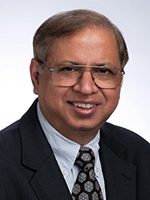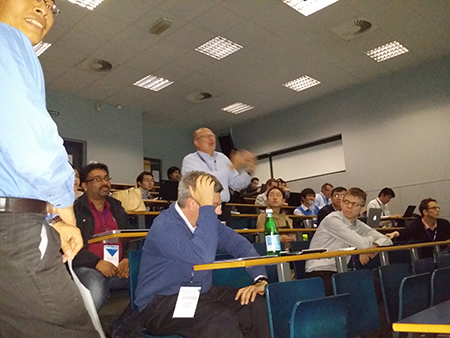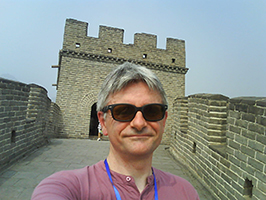Technical Program
The proceedings can be found in the ACM digital library.
Workshop room: Amphi Herpin, Batiment Esclangon, UPMC, 4 Place Jussieu, Paris, France. Directions here.
Duration: 8:50 - 17:30
| 8:00 - 8:50 | Registration |
| 8:50 - 9:00 | Welcome |
| 9:00 - 9:40 | Keynote 1 |
| Session Chair: Stefano Secci, UPMC. |
Virtualization techniques for redesigning mobile backhaul networks: challenges and issues
[slides]
|
Fabrice Guillemin |
Mobile networks will have to cope in the next future with a dramatic increase of the volume of data traffic, boosted by the widespread of connected terminals (smartphones, tablets and associated devices). Users eventually expect to use their radio connections independently of the access technology, whether through WiFi or 4G/5G, and to seamlessly move from one access technology to the other.
This situation urges operators to implement a real fixed/mobile convergence, which has been for decades a recurrent issue in the design of telecommunication networks. Mobile and fixed networks have been developed independently one of each other, mobile networks relying on highly centralized platforms and a few gateways to interconnect with the Internet for data traffic. One major obstacle to fixed/mobile convergence is that networks are built upon functions hosted by dedicated hardware (e.g., the functions of the evolved packet core for cellular networks). But the rapid development of virtualization and cloud computing techniques opens the door to new opportunities of realizing fixed/mobile convergence. As a matter of fact, those technologies make it possible to host on the same piece of equipment or in the cloud cellular and fixed access functions. |
Fabrice Guillemin graduated from Ecole Polytechnique in 1987 and from Telecom Paris in 1989. He received the PhD degree in computer science from the University of Rennes in 1992 and defended his habilitation thesis at the University Pierre and Marie Curie in 1999. Since 1989, he has been with the R&D center of France Telecom (former CNET) in Lannion. He participated in the Metropolis project (metrology of Internet traffic) and was the project leader of the ASIA (lightweight signaling for the Internet over ATM) and OSCAR (security in overlay networks) funded by the French national agency for research. He also participated in the European projects Evergrow and 4WARD (Internet of the future). Fabrice Guillemin was also involved in the standardization of the ATM technology (ATM Forum and ITU). His research interests are in queuing theory and probability applied to congestion control and traffic metrology in telecommunication networks (Internet and mobile networks). Fabrice Guillemin is currently leading a project on the evolution of the control planes of networks at Orange Labs. Fabrice Guillemin is member of the Orange Expert Community “Network of the Future” and an external collaborator of the INRIA project RAP (Networks, Algorithms and Probability). |
|
| 9:40 - 10:40 | Session 1: Mobile Offloading |
| Session chair: Stefano Secci, UPMC. |
- Mobile Data Offloading: An Experimental Evaluation (invited paper)
by Matteo Pozza, Claudio Enrico Palazzi, Armir Bujari (University of Padova, Italy).
- Network Store: Exploring Slicing in Future 5G Networks
by Navid Nikaein, Romain Favraud (EURECOM, France); Eryk Schiller, Islam Alyafawi, Zhongliang Zhao, Torsten Braun (University of Bern, Switzerland); Kostas Katsalis, Donatos Stavropoulos, Thanasis (University of Thessaly, Greece).
Coffee break
| 11:00 - 12:30 | Session 2: Content Distribution |
| Session chair: Jeremie Leguay, Huawei Research France. |
- sNDN: a Social-aware Named Data Framework for Cooperative Content Retrieval via D2D Communications
by Lingjun Pu (University of Goettingen, Germany; Nankai University, China); Xu Chen (University of Goettingen, Germany); Jingdong Xu (Nankai University, China); Xiaoming Fu (University of Goettingen, Germany).
- Krowd: A Key-Value Store for Crowded Venues
by Utsav Drolia, Nathan Mickulicz, Rajeev Gandhi, Priya Narasimhan (Carnegie Mellon University, USA).
BEST PAPER AWARD
- Splitting Control-User Plane on Communication Protocol for Spotty Network
by Atsushi Tagami, Kenji Yokota, Chikara Sasaki (KDDI, Japan); Katsunori Yamaoka (Tokyo Institute of Technology, Japan).
Lunch break
| 14:00 - 14:40 | Keynote 2 |
| Session chair: Xiaoming Fu, Univ. Goettingen. |
Future Communication Clouds
[slides]
 Krishan Sabnani Alcatel-Lucent Bell Labs, USA |
For handling exponential growth in mobile data consisting of mostly short packets, networks have been enhanced rapidly. Some of the new techniques being used in next-gen networks are massive MIMO and mm waves. Tight delay needs, especially for a new class of resource- and interaction-intensive applications, cannot be met through only enhancing networks. A solution is to create an overlay network of Cloudlets. Such edge computing also helps in virtualizing network functions (aka NFV – Network Function Virtualization). Rapid traffic growth requires doubling network capacity every year. Service providers need to find smart ways of maximizing use of current capacity to minimize swap outs. Two sample solutions will be presented: preloading of content using a Mobile Smartloading and download of video content during good network connectivity using Smart Video Streaming. |
Krishan Sabnani is a Research VP at Bell Labs responsible for research on NFV and web communications. Previously he was the VP of Networking Research from Jan. 2000 to Sept. 2013. Krishan has made many seminal contributions to the Internet infrastructure design, protocol design, and wireless networks. |
|
| 14:40 - 15:40 | Session 3: Mobility Analysis |
| Session chair: Xiaoming Fu, Univ. Goettingen. |
- Energy-efficient Position Tracking via Trajectory Modeling
by Andrea Nodari, Jukka Nurminen, Matti Siekkinen (Aalto University, Finland).
- Prediction of User Mobility Pattern on a Network Traffic Analysis Platform
by Haiyang He, Yuanyuan Qiao, Sheng Gao, Jie Yang, Jun Guo (Beijing University of Posts and Telecommunications, China).
Coffee break
| 15:40 - 17:30 | Poster session |
| Session chair: Sahar Hoteit, Centrale-Supelec. |
- A Base Station Workload-Aware Dynamic Pricing Scheme for Mobile Internet Access
by Agripino Gabriel Miranda Damasceno (PUC Minas, Brazil); Jussara Almeida (UFMG, Brazil); Raquel Mini, Humberto T. Marques-Neto (PUC Minas, Brazil).
- Towards an Architecture to Support Complex Multihomed Mobility Scenarios
by Ibrahim Alsukayti, Christopher Edwards (Lancaster University, UK).
- Mobile Multipath Data Transfer over Multirate Wi-Fi Links
by Vasilios Siris, Dimitrios Dimopoulos (Athens University of Economics and Business, Greece).
- An Agile Mobile Cloud Protocol Architecture (invited poster)
by Patrick Raad (UPMC, France).
- Cloudlet Network Design (invited poster)
by Alberto Ceselli (LIPN - Paris XIII, France).
- Adaptive Grouping of Mobile Applications via Data Analytics (invited poster)
by Keun-Woo Lim (UPMC, France).


